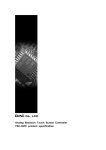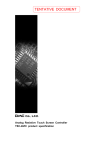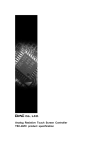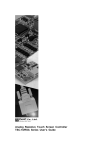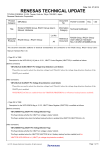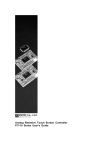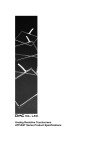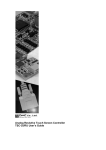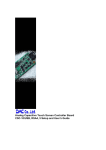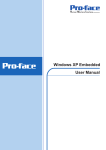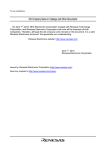Download DMC TSC-34/U-L Specifications
Transcript
TENTATIVE DOCUMENT Analog Resistive Touch Screen Controller TSC-30/IC product specification TSC-30/IC Product Specification Table of Contents 1. Products outline ...................................................................................................................... 2 1-1. Scope of Application ........................................................................................................................2 1-2. Outline ...............................................................................................................................................2 1-3. Features ............................................................................................................................................2 1-4. General specification ........................................................................................................................3 2. Pin layout and representation................................................................................................ 4 3. Pin functions............................................................................................................................ 5 4. Initial setting ............................................................................................................................ 7 4-1. EEPROM setting ..............................................................................................................................7 4-2. Communication mode setting ..........................................................................................................7 4-3. Touch screen mode setting.............................................................................................................7 4-4. Configuration in USB mode.............................................................................................................8 4-5. Panel ID setting (USB mode) .........................................................................................................8 5. Data sheet ................................................................................................................................ 9 5-1. Absolute maximum rating ................................................................................................................9 5-2. Recommended operational conditions...........................................................................................10 5-3. Timing requirement.........................................................................................................................12 5-4. DC standards..................................................................................................................................14 6. Packaging Specification ....................................................................................................... 16 6-1. Outline .............................................................................................................................................16 6-2. Notes on storage/handling .............................................................................................................16 6-3. Basic packaging .............................................................................................................................16 6-4. Small group packaging ..................................................................................................................17 6-5. Tray specification............................................................................................................................18 6-6. Product name label specification ..................................................................................................18 7. Storage Specification............................................................................................................ 19 7-1. Storage Conditions .........................................................................................................................19 7-2. Baking .............................................................................................................................................19 8. Implementation Temperature Specification ....................................................................... 20 9. Cleaning ................................................................................................................................. 21 10Changes and improvements ................................................................................................ 22 10-1. Version history..............................................................................................................................22 11. Warranty ............................................................................................................................... 23 11-1. Warranty Period............................................................................................................................23 11-2. Warranty Target............................................................................................................................23 11-3. Warranty Exceptions.....................................................................................................................23 12. Notes on use ........................................................................................................................ 24 12-1. Overall handling............................................................................................................................24 12-2. Others............................................................................................................................................24 Dimensional Drawing Circuit Diagram 1 Version 0.3 ©2007 DMC Co., Ltd. TSC-30/IC Product Specification 1. Products outline 1-1. Scope of Application This specification applies to the TSC-30/IC. 1-2. Outline TSC-30/IC is an analog touch screen control IC that performs A/D conversion on analog signal for the 4-wire, 5-wire and 8-wire resistive analog touch screen, and transmits coordination data with 10bit resolution to the host in a 9600bps serial (asynchronous) and USB. At the coordinate detection, internal filtering process provides a stabilized coordinate value. By using the correction function, in addition to the losses that occur in the circuit, display deflection between touch screen input point that occur in each element and indicator cursor can be corrected to adjust the display position. 1-3. Features § Two coordinate output modes are provided and selected per application: “Coordinate data mode” where coordinate information is sent with 10bit resolution as it is, and “correction data mode” where read coordinate is converted to the indicator’s display coordinate and sent. § “Correction data mode“ is available after EEPROM is externally attached. It enables to set up to nine correction points. Coordinate data can be corrected with the base of correction points. Using this function allows the host driver to make the implementation of correction function unnecessary. In addition, by placing correction points at the touch screen center and center points of four edges of touch screen, resistance value deviation of transparent electrode film can be corrected. § USB has multi-touch screen function enable two simultaneous connections to the host. § Two external switch functions are always available in the coordinate (correction) data mode. Two pieces of external switch information are, at the transmission of coordinate data, included in the coordinate data as pen-down/pen-up information. Since in the pen-up mode, pen-up data can be always output to the host, this switch is available as a function switch. § At the touch screen input, buzzer and LED outputs are available. Input confirmation via display and sound is available. § In the serial communication, when no touch screen input is performed, the state moves to “power-save mode“ so that such application can be supported that requests a low power consumption. In USB mode, USB suspend is supported and restored by the external interrupt of touch screen input. § Seven types of coordinate output rates are provided and either can be selected per application among seven types: six types from 30 to 150p/s plus one type, a point mode that outputs the coordinate only one time when pen-down is performed. 2 Version 0.3 ©2007 DMC Co., Ltd. TSC-30/IC Product Specification 1-4. General specification Item Power supply voltage Power consumption Asynchronous serial Operating Temp USB Temperature range at storing Communication scheme (serial) Notes 125mW (standard) Power supply voltage is 5V. 30mW (standard) Power supply voltage is 3.3V. -20 ˚C to +85 ˚C (No dew condensation) 0 ˚C to +70 ˚C (No dew condensation) -40 ˚C to +125 ˚C (No dew condensation) Communication scheme Asynchronous, serial Communication rate 9600bps Data length 8bits Stop bit 1bit Parity None Transfer rate Communication scheme (USB) Rating DC 3.00V to 5.25V Transfer mode Each setting is fixed USB Specification2.0 Full Speed Control transfer (command) Interrupt transfer (coordinate) Operation frequency 6MHz Fixed to 6MHz Coordinate output rate (point / second) (1) Point mode (2) 30p/s (3) 50p/s (4) 80p/s (5) 100p/s (6) 130p/s (7) 150p/s Point Mode: Only when touch screen is input, pen-down ID is sent once. After input ends, no pen-up ID is sent. Linearity error ±3 LSB Input response time - Coordinate resolution 10bit (1024×1024) Dimension (mm) 12×12×1.7 3 In the correction data function, resolution follows the setting value Version 0.3 ©2007 DMC Co., Ltd. TSC-30/IC Product Specification PANEL_THOb1 PANEL_THOb2 PANEL_THOb3 PEN_UP USB_PW BEEP RxD_I 41 40 39 38 37 36 35 33 PANEL_THOa 42 34 PANEL_THI 43 44 45 EEP-DO/JP12 47 46 EEP-DI/JP11 48 2. Pin layout and representation EEP-CLK/JP10 49 32 PANEL_UR EEP-CS/JP9 50 31 PANEL_LL RxD 51 30 PANEL_XR/LR TxD 52 29 PANEL_XL/UR 28 PANEL_YU/UL 27 PANEL_YD/LL 26 D- 25 D+ 24 TrON 23 USBVref 22 Vcc 21 Vcc 20 Vss TSC-30x 53 54 12 13 14 15 16 Xout Vcc Vss LED0 PANEL_AD_XL Xin 64 11 PANEL_AD_YU Vss 63 10 PANEL_AD_YD 19 INDEX Vref 62 9 JP8 Vcc 61 8 JP7 RESET 60 7 JP6 #### CNVss 59 6 JP5 5 58 4 JP4 xxx SW1 57 3 JP3 SW0 56 2 JP2 PANEL_AD_XR 55 1 JP1 18 LED2 17 LED1 Marking specification TSC-30x Product number x: version number xxx ROM number #### Lot number 4 Version 0.3 ©2007 DMC Co., Ltd. TSC-30/IC Product Specification 3. Pin functions Pin number Pin name I/O Functional description 1 PANEL_AD_XL I Touch Screen XL input pin. 2 PANEL_AD_XR I Touch Screen XR input pin. 3 SW0 I SW0 input pin; H=ON=1, L=OFF=0. 4 SW1 I SW1 input pin; H=ON=1, L=OFF=0. 5 I Unused pin. Via resistance; Vcc is connected. 6 I Unused pin. Via resistance; Vcc is connected. 7 CNVss P Vss is connected. 8 RESET I Reset input pin (active L). 9 Vcc P Power supply input pin; Vcc is connected. 10 Vref P A/D converter reference voltage input pin; Vcc is connected. 11 Vss P Power supply input pin (GND); GND is connected. 12 Xin I Clock input pin; When using external clock, clock is input to this pin. 13 Xout O Clock output pin; When using external clock, this pin is opened. 14 Vcc P Power supply input pin; Vcc is connected. 15 Vss P Power supply input pin (GND); GND is connected. 16 LED0 O LED output pin; When internal initialization was finished correctly, output L. 17 LED1 O LED output pin; Touch input, ON=L, OFF=H. 18 LED2 O LED output pin; When a response for the command is NAK, output L. 19 O Unused pin; Opened. 20 Vss P Power supply input pin (GND); GND is connected. 21 Vcc P Power supply input pin; Vcc is connected. 22 Vcc P 23 USBVref P 24 TrON O 25 D+ I/O 26 D- I/O Power supply input pin; Vcc is connected. USB reference voltage input pin. If Vcc is 3.3V, Vcc is connected. If Vcc is 5V, GND is connected via capacitor. Identification signal for USB. D+ is connected via resistance (1.5k ohm). Data send/receive pin; In USB mode, D+ pin. In serial mode, GND is connected via resistance (1k to 10k ohm). Data send/receive pin; In USB mode, D- pin. In serial mode, GND is connected via resistance (1k to 10k ohm). 27 PANEL_YD/LL O Touch screen control pin. 28 PANEL_YU/UL O Touch screen control pin. 29 PANEL_XL/UR O Touch screen control pin. 30 PANEL_XR/LR O Touch screen control pin. 31 PANEL_LL O Touch screen control pin. Used only in 5-wire mode. In 4-wire mode, opened. 32 PANEL_UR O Touch screen control pin. Used only in 5-wire mode. In 4-wire mode, opened. 33 O Unused pin; Opened. 34 O Unused pin; Opened. 35 RxD_I I In sleep mode, start signal input pin by command reception. Only used serial communication mode. 36 BEEP O BEEP output pin; H output. 37 USB_PW I USB power supply detection pin. In USB mode, USB-Vbus is connected. *1 In serial mode, GND is connected. 38 PEN_UP I GND is connected. 39 PANEL_THOb3 I/O Touch screen control pin. Used only in 5-wire mode. In 4-wire mode, opened. 5 Version 0.3 ©2007 DMC Co., Ltd. TSC-30/IC Product Specification 40 PANEL_THOb2 I/O Touch screen control pin. Used only in 5-wire mode. In 4-wire mode, opened. 41 PANEL_THOb1 I/O Touch screen control pin. Used only in 5-wire mode. In 4-wire mode, opened. 42 PANEL_THOa I/O Pen down detection pin. 43 PANEL_THI I In sleep mode, start signal input pin by pen down. 44 O Unused pin; Opened. 45 O Unused pin; Opened. 46 O Unused pin; Opened. Vcc is connected. When using EEPROM, EEPROM DO is connected. When using EEPROM, EEPROM DI is connected. When not using EEPROM, Vcc is connected via resistance. When using EEPROM, EEPROM SK is connected. When not using EEPROM, Vcc is connected via resistance. EEPROM setting pin shared with EEPROM CS signal output pin. EEPROM is set via resistance and Vcc or GND is connected. (L=Used, H=Not used) When using EEPROM, EEPROM CS is connected. 47 EEP-DO/JP12 I 48 EEP-DI/JP11 I/O 49 EEP-CLK/JP10 I/O 50 EEP-CS/JP9 I/O 51 RxD I In serial mode, data receive pin. 52 TxD O In serial mode, data send pin. 53 O Unused pin; Opened. 54 O Unused pin; Opened. 55 JP1 I GND is connected. 56 JP2 I GND is connected. 57 JP3 I GND is connected. 58 JP4 I Panel ID select pin. 59 JP5 I Panel ID select pin. 60 JP6 I Touch screen mode setting pin; L=4 / 8 wire, H=5-wire 61 JP7 I Touch screen mode setting pin; L=4 / 5 wire, H=8-wire 62 JP8 I In USB mode, if Vcc is 5V, Vcc is connected via resistance. If Vcc is 3.3V, GND is connected. In serial mode, Vcc is connected via resistance or GND is connected. 63 PANEL_AD_YD I Touch Screen YD input pin. 64 PANEL_AD_YU I Touch Screen YU input pin. *1: Please be careful if you use a external power supply not to exceed the power supply voltage in this terminal. 6 Version 0.3 ©2007 DMC Co., Ltd. TSC-30/IC Product Specification 4. Initial setting 4-1. EEPROM setting Depending on that calibration is performed in either TSC-30/IC or host, you can select whether EEPROM is used or not to store the correction data. EEPROM selection can be set via pin number 50, where hardware reset release enables the setting. (TSC-30/IC) VCC (EEPROM) H= Not used EEP-CS/JP9 L= Used CS 4-2. Communication mode setting Communication mode setting for serial/USB is performed by setting pin number 37 to “H” or “L”. When power supply is turned on, or hardware reset is released, pin number 37 is read to turn on in either USB/ serial mode. No both communication schemes are used at a time. After the hardware reset, if setting is performed with jumper switch, the setting is enabled by power supply restart or hardware reset. (TSC-30/IC) VCC H = USB USB_PW L= Serial 4-3. Touch screen mode setting Touch screen mode setting for 4-wire, 5-wire or 8-wire is performed by setting pin number 60 and 61 to “H” or “L”. When power supply is turned on, or hardware reset is released, pin number 60 and 61 are read to turn on in either 4-wire, 5-wire or 8-wire mode. Mode Pin number 60 Pin number 61 4-wire touch screen GND GND 5-wire touch screen Vcc GND 8-wire touch screen GND Vcc 7 Version 0.3 ©2007 DMC Co., Ltd. TSC-30/IC Product Specification 4-4. Configuration in USB mode § Basic configuration Item § Specification USB standard Specification Rev2.0 Full Speed Power supply Bus power supply / Self-Power Device class Vendor definition Interrupt (coordinate) transfer interval 1ms End point buffer size EP0: 8byte EP1: 5byte (EP0: control transfer, EP1: interrupt transfer) Connection with Host Coordinate data, correction value or other various output data are all output to the host as a response to IN token. Output coordinate in coordinate data mode and correction data mode is output in the interrupt transfer, while other data is output to the host with control transfer. Host TSC-10/IC Control transfer Buffer End Point 0 IN/OUT (Descriptor, Device Request (command)) Interrupt transfer (Coordinate data) Buffer End Point 1 IN 4-5. Panel ID setting (USB mode) If two (three or four) touch screens to the same host are connected simultaneously, each TSC-30/IC to the host needs panel ID setting. This function is enabled in the USB mode, by setting pin number 58 (JP4) and pin number 59 (JP5) to “H” or “L”. Setting is enabled when hardware is reset, where Device Descriptor’s iProduct is set to “0” or “1” and this value is identified by the VCC host as panel ID. (TSC-30/IC) JP4 JP5 iProduct Panel ID L L 00h 0 H L 01h 1 L H 02h 2 H H 03h 3 H L JP4 VCC H JP5 L 8 Version 0.3 ©2007 DMC Co., Ltd. TSC-30/IC Product Specification 5. Data sheet 5-1. Absolute maximum rating Item Power supply voltage Symbol Rating Minimum Maximum Unit VCC -0.3 6.5 V Input voltage VI -0.3 Vcc+0.3 V Output voltage VO -0.3 Vcc+0.3 V Power consumption 500 mW Operation temperature TOPR PD -20 +85 ˚C Storage temperature TSTG -40 +125 ˚C 9 Description Ta=25˚C Version 0.3 ©2007 DMC Co., Ltd. TSC-30/IC Product Specification 5-2. Recommended operational conditions Item Rating Symbol Unit Minimum Standard Maximum 3.00 5.00 5.25 Power supply voltage Vcc Analog reference voltage AVcc Analog reference voltage AVREF Analog reference voltage USB USBVREF Power supply voltage Vss 0 V Analog reference voltage AVss 0 V “H” input voltage (Pin number 16-19, 27-50) “H” input voltage (Pin number 1-6, 51-64) “H” input voltage RESET, XIN, Pin number 7, 15 “H” input voltage D+, D“L” input voltage (Pin number 16-19, 27-50) “L” input voltage (Pin number 1-6, 51-64) “L” input voltage RESET, XIN, Pin number 7, 15 “L” input voltage D+, D“H” output total peak current *1 (Pin number 16-19, 27-50) “H” output total peak current *1 (Pin number 1-6, 51-64) “L” output total peak current *1 (Pin number 27-50) “L” output total peak current *1 (Pin number 16-19) “L” output total peak current *1 (Pin number 1-6, 51-64) “H” output total average current*1 (Pin number 16-19, 27-50) “H” output total average current*1 (Pin number 1-6, 51-64) “L” output total average current*1 (Pin number 27-50) “L” output total average current*1 (Pin number 16-19) “L” output total average current *1 (pin number 1-6, 51-64) “H” output peak current *2 (Pin number 16-19, 27-50) “H” output peak current *2 (Pin number 1-6, 51-64) Vcc Description V V 2.0 Vcc V 3.0 3.6 V Vcc=3.6 to 4.0V 3.0 Vcc V Vcc=3.0 to 3.6V VIH 0.8Vcc Vcc V VIH 0.8Vcc Vcc V VIH 0.8Vcc Vcc V VIH 2.0 3.6 V VIL 0 0.2Vcc V VIL 0 0.2Vcc V VIL 0 0.2VCC V VIL 0 0.8 V ΣIOH (peak) -80 mA ΣIOH (peak) -80 mA ΣIOL (peak) 80 mA ΣIOL (peak) 80 mA ΣIOL (peak) 80 mA ΣIOH (avg) -40 mA ΣIOH (avg) -40 mA ΣIOL (avg) 40 mA ΣIOL (avg) 40 mA ΣIOL (avg) 40 mA IOH (peak) -10 mA IOH (peak) -10 mA 10 Version 0.3 ©2007 DMC Co., Ltd. TSC-30/IC Product Specification “L” output peak current *2 (Pin number 27-50) “L” output peak current *2 (Pin number 16-19) “L” output peak current *2 (Pin number 1-6, 51-64) “H” output average current *3 (Pin number 16-19, 27-50) “H” output average current *3 (Pin number 1-6, 51-64) “L” output average current *3 (Pin number 27-50) “L” output average current *3 (Pin number 16-19) “L” output average current *3 (Pin number 1-6, 51-64) Vibration frequency *4 IOH (peak) 10 mA IOH (peak) 20 mA IOH (peak) 10 mA IOH (avg) -5 mA IOH (avg) -5 mA IOL (avg) 5 mA IOL (avg) 10 mA IOL (avg) 5 mA XIN 6.0 MHz *1 The total peak output current is the absolute value of the peak currents flowing through all the applicable ports. The total average output current is the average value of the absolute value of the currents measured over 100ms flowing through all the applicable ports. *2 The peak output current is the absolute value of the peak current flowing in each port. *3 The average output current is the average value of the absolute value of the currents measured over 100ms. *4 The duty of oscillation frequency is 50%. 11 Version 0.3 ©2007 DMC Co., Ltd. TSC-30/IC Product Specification 5-3. Timing requirement § Reset (Vcc = 3.0 to 5.25V , Vss = 0V , Ta = -20 to 85°C) Item Symbol RESET L width tw Rating Minimum Maximum 2 Unit Description μs tw RESET 0.8Vcc 0.8Vcc 0.2Vcc § 0.2Vcc Power-on reset Reset input voltage shall be 0.6V or below at the timing when power supply voltage crosses 3.0V. (Ta = -20 to 85°C) (PWR ON) 3.0V Reset release voltage: Vcc = 3.0V VCC ≦0.2Vcc RESET 12 Version 0.3 ©2007 DMC Co., Ltd. TSC-30/IC Product Specification § External clock timing Rating Item Symbol Input cycle Clock pulse width tC tWH, tWL Minimum Maximum 166 70 Unit Description ns ns tC tWH tWL 0.8VCC 0.2VCC XIN § Clock input circuit Using ceramic vibrator External clock input circuit CIN XIN XIN XOUT Open XOUT COUT 13 Version 0.3 ©2007 DMC Co., Ltd. TSC-30/IC Product Specification 5-4. DC standards (Vcc=3.00 to 5.25V, Vss=0V, Ta=-20 to 85˚C, unless otherwise noted) Item Symbol Rating Condition Minimum IOH = -10mA “H” Output voltage (Pin number 16-19, 27-50) VOH VCC = 4.0 to 5.25V IOH = -1.0mA IOH = -10mA “H” Output voltage (Pin number 1-6, 51-64) “H” Output voltage (Pin number. 25 (D+), 26 (D-)) VOH VOH VCC = 4.0 to 5.25V IOH = -1mA Pull-down with 0V via a resistor of 15kΩ±5% Standard Vcc-2.0 V VCC-1.0 Vcc-2.0 Vcc-1.0 2.8 3.6 IOL = 10mA “L” Output voltage (Pin number 27-50) VOL (Pin number 16-19) “L” Output voltage (Pin number. 25 (D+), 26 (D-)) VOL VOL V IOL = 1mA 1.0 2.0 VCC = 4.0 to 5.25V V IOL = 1mA 1.0 Pull-up with 3.6V via a 0.3 resistor of 15kΩ±5% IOL = 10mA “L” Output voltage (Pin number 1-6, 51-64) hysteresis (Pin number 35-37) hysteresis (Pin number 1-6, 51-64) hysteresis (Pin number 25(D+), 26(D-)) hysteresis (Pin number 8) “H” Input current (Pin number 16-19, 27-50) “H” Input current (Pin number 1-6, 51-64) “H” Input current (Pin number 7, 8) “H” Input current (Pin number 12) “L” Input current (Pin number 16-19, 27-50) Input “L” current (Pin number 1-6, 51-64) Input “L” current (Pin number 7, 8, 15) Input “L” current (Pin number 12) VOL V 2.0 VCC = 4.0 to 5.25V IOL = 20mA “L” Output voltage Unit Maximum V 2.0 VCC = 4.0 to 5.25V V IOL = 1mA 1.0 VT+ - VT- 0.6 V VT+ - VT- 0.6 V VT+ - VT- 0.25 V VT+ - VT- 0.5 V IIH VI = VCC 5.0 μA IIH VI = VCC 5.0 μA IIH VI = VCC 5.0 μA IIH VI = VCC IIL VI = VSS -5.0 μA IIL VI = VSS -5.0 μA IIL VI = VSS -5.0 μA IIL VI = VSS 14 4.0 -4.0 μA μA Version 0.3 ©2007 DMC Co., Ltd. TSC-30/IC Product Specification Normal Icc1 mode *1 Power supply current Icc2 3.0 to 4.0V Vcc= *2 3.0 to 5.25V suspend mode*3 2.1 Vcc= STOP mode At USB Icc3 Vcc= 4.0 to 5.25V Vcc= 4.0 to 5.25V Vcc= 3.0 to 5.25V 60 mA 35 mA 2.0 125.0 0.1 mA 250 uA uA *1: All USB difference-input circuits enabled. Leaving I/O pins open. Operating functions: CPU, Timers *2: All USB difference-input circuits enabled. Leaving I/O pins open. Operating functions: Timers, USB receiving. Disabled functions: CPU. *3: All USB difference-input circuits disabled. Leaving I/O pins open. Oscillation stopped. 15 Version 0.3 ©2007 DMC Co., Ltd. TSC-30/IC Product Specification 6. Packaging Specification 6-1. Outline With a basic packaging unit of 800, TSC-20/IC is packaged for the number of 800 and its multiple using damp-proof aluminum laminate bags (Basic packaging). If the delivery quantity is less than 800 or not multiple of 800, or the product can not be packaged with a unit of 800, then no damp-proof packaging specification is applicable (Small group packaging). If packaged with small group packaging, the products may be dampened. Before packaging, the product shall take the baking process as specified in [Baking] defined in “7. Storage Specification”. 6-2. Notes on storage/handling (1) Handle the packages with care and avoid throwing and dropping them. Or, a large impact may be imposed, causing packaging material’s damage, broken package or bending lead. (2) Cardboard box may be deteriorated in its strength and deformed due to storage site’s humidity, stacking condition and storage duration. It is desirable to keep the storage under normal temperature/humidity (5 to 35 °C, 45 to 75%RH). For warehousing, follow the FIFO principle. (3) After unpacking, be careful in handling the product to avoid electrostatic breakdown. 6-3. Basic packaging 6-3-1. Packaging type Damp-proof packaging (Aluminum laminate bag) 6-3-2. Packaging quantity specification Quantity per tray Number of trays 160 5 + 1(cover) Desiccant Quantity per packages 800 Tray Product name label Aluminum laminate bag Humidity indicator Packaging label Packaging label Product name label Packaging box 16 Version 0.3 ©2007 DMC Co., Ltd. TSC-30/IC Product Specification 6-3-3. Diagram for packaging box sizes L: 351 W: 148 D: 55 (mm) 6-4. Small group packaging 6-4-1. Packaging type General packaging (No damp-proof processing) 6-4-2. Packaging quantity specification Quantity per tray Number of trays 160 1 – 5 + 1(cover) Desiccant Quantity per packages 1 - 799 Number of trays: 1 to 5 (Additionally, one dummy tray pl aced at the top for reinforcing) Air cap Product name label Antistatic bag * No sizes specified for packaging box (Cardboard box) used for transportation. 17 Version 0.3 ©2007 DMC Co., Ltd. TSC-30/IC Product Specification 6-5. Tray specification This tray is heat-proof type, allowing the heating with 125 °C for 24 hours. During heating/cooling process, however, bending may occur. In baking process, to minimize the bending, heat and cool the tray by placing it on a flat plate. 6-6. Product name label specification DMC P/N: Product number (TSC-30/IC) QTY: Quantity DAC: DMC Control Number 18 Version 0.3 ©2007 DMC Co., Ltd. TSC-30/IC Product Specification 7. Storage Specification 7-1. Storage Conditions For storing the product until its implementation, it is recommended that the following storage conditions are applied: 1. Before unpacking the damp-proof package (Aluminum laminate bag) Temperature and humidity: 5 to 40 °C, 20 - 80%RH Duration: Two years or less 2. After unpacking the damp-proof package (Aluminum laminate bag) For the storing duration after the damp-proof package is unpacked and before the implementation, it is recommended that the following storage conditions is to be applied: (1) Reflow method: Two weeks or less under the ambient condition: 30 °C, 70%RH or less 3. Temporary storage after damp-proof package is unpacked To store again temporarily the once unpacked and unused damp-proof package, it is recommended to pack it again into another damp-proof bag with desiccant within a shorter time after opened (Around 10 minutes) as far as possible, and fold the bag’s opening, followed by sealing with adhesive material such as adhesive tape, then store it under the following conditions: Temperature, humidity: 5 to 40 °C, 20 - 80%RH Duration: One month or less 7-2. Baking If any condition among those 1 to 3 listed below is applicable, it is recommended to apply the baking as described below to dry the moisture the package absorbs. You may place the tray used for damp-proof packaging directly into the thermostatic chamber since the tray is heat-proof type. When placing into the chamber or after removing from it, to avoid deformation, cool the tray by placing it on the flat plate such as surface table. 1. Any condition among 1 to 3 in [7-1. Storage condition] is unsatisfied 2. Indicator’s 30% Humidity Check section changes the color to lavender or pink 3. Blue color indicator of desiccant (Silica gel) changes to pink or white Baking method Temperature: 125 °C Duration: 20 to 24 hours Frequency: Four times or less (Upper limit: 96 accumulative hours) 19 Version 0.3 ©2007 DMC Co., Ltd. TSC-30/IC Product Specification 8. Implementation Temperature Specification We do not recommend the wave soldering method. 1. Reflow method (Infrared reflow, air reflow) Frequency: Three times or less Temperature: The following device surface temperature profile is recommended. 260 °C max. Package’s surface temperature 255 °C or higher, 10s max. 220 °C or higher, 50s max. 200 °C or higher, 70s max. 175±10 °C 1 to 4 °C/s 110±20s Time Figure 1: Infrared reflow, air reflow temperature profile 2. Soldering iron (Manual soldering) Soldering bit’s temperature: Soldering time: 370 °C or lower Five seconds or less/terminal 20 Version 0.3 ©2007 DMC Co., Ltd. TSC-30/IC Product Specification 9. Cleaning In case of cleaning boards with solvents after soldering, following items should be taken attention. *Administrative guidance and regulation. *Residual ionic (non ionic) contamination. *Solvent resistance of parts. 21 Version 0.3 ©2007 DMC Co., Ltd. TSC-30/IC Product Specification 10Changes and improvements 10-1. Version history § TSC-30/IC Ver0.1 (July 31, 2007) Draft release Ver0.2 (September 27, 2007) 2. Pin layout Pin layout was changed. (SW0, SW1, LED0, LED2, RxD_I) 3. Pin functions Pin functions were changed. (LED0, LED2, USB_PW, EEP-DI/JP11, EEP-CLK/JP10, JP3, JP8) 4-2. Communication mode setting Terminal number was changed from 57 to 37. 4-5. Panel ID setting (USB mode) Replaced setting of JP4 with JP5. “6. Packing Specification” was added. “7. Storage Specification” was added. “8. Implementation Temperature Specification” was added. “9. Cleaning” was added. Ver0.3 (November 29, 2007) 1-2. Outline 8-wire touch screen was added. 3. Pin function Pin functions were changed. (USBVref, USB_PW, JP6, JP7) 4-3. Touch screen mode setting 8-wire touch screen mode was added. 6-6. Product name label specification “Pb Free” was added. Circuit Diagram In USB mode, Vcc is 3.3V, it changed the circuit of the USB_PW terminal. Circuit Diagram A capacitor was added to a power I/F circuit. 22 Version 0.3 ©2007 DMC Co., Ltd. TSC-30/IC Product Specification 11. Warranty 11-1. Warranty Period § The warranty period is limited to 1 year from the date of shipping. The warranty for the initial defection such as appearance defection is limited to 1 month. § Any defected parts under proper use will be examined by the supplier and replaced by the new parts if the defection is considered to be caused by the supplier. § The replacement is subject to be included in the next lot. 11-2. Warranty Target § The warranty only covers the product itself and does not cover any damage to others caused by using this product. Onsite repair or replacement is not supported. § We will do our best for delivery problem and product defections, but the warranty for the production line is not covered. 11-3. Warranty Exceptions Following conditions are not covered with the warranty and subject to charge. § Any malfunctions and damages during transportation and transfer by the user. § Any malfunctions and damages caused by a natural disaster or a fire. § Any malfunctions and damages caused by static electricity § Any malfunctions and damages caused by the failure of the associated equipment. § If the product is remodeled, disassembled or repaired by the user. § If the product is glued onto the equipment and uninstalled. § Any malfunctions and damages caused by an improper usage and handling against the specifications and notes. 23 Version 0.3 ©2007 DMC Co., Ltd. TSC-30/IC Product Specification 12. Notes on use 12-1. Overall handling § When using the product, do not place it close to, or make it contact with, the conductive materials such as metal. § Do not touch the metal part in the product directly with your hands. Or, it may be destructed by the static electricity. If you contact, or may contact, it directly with your hand, prepare in advance the measure against static electricity. § To store the product, use an appropriate packing box and keep the storage temperature range with no overload on it. § In using the product or storing it, avoid the following conditions: - Conditions where water is, or may be, attached to the product. - Conditions where condensation takes place, or may take place. - In the ambience of organic solvent or acidity or contact, or where the product contacts them. § Do not alter or disassemble the product. 12-2. Others § This specification may be changed for improvement without prior notices. § No liabilities are taken by us for any damage caused by use of this product. § This product intends to be used for the standard applications (e.g. office equipment and OA devices, industrial use, communication devices, household equipment). Avoid its use where failure or malfunction directly may affect the human body or special applications where extremely high reliability is required (e.g. airline and space industries, nuclear controls, medical use for life-sustaining). § Semi-conductor devices may fail in a certain possibility. Keep the safety design in your mind so that possible failure in this product shall not cause physical accidents such as injury and death, fire and other social damages. TSC-30/IC Product Specification Version 0.3: Issued at November 29, 2007 ©2007 DMC Co., Ltd. This document is allowed to redistribute but no alteration, part or all, is prohibited. http://www.dmccoltd.com/english/ 9F Kanda Sent-Building 1-2-4, Yushima, Bunkyo-ku, Tokyo, 113-0034 Japan Phone: +81-3-5209-7131 (Japanese), 7135 (English) Fax: +82-3-5209-7130 24 Version 0.3 ©2007 DMC Co., Ltd.



































